Family name: Colchicaceae DC.
Synonym(s): Bulbocodiaceae Salisb.; Burchardiaceae Takht.; Uvulariaceae A. Gray ex Kunth, nom. cons.
Common name(s): autumn-crocus family
*Number of genera/species: 15/285
List of genera records in GRIN-Global
fruit or seed
Fruit a loculicidalloculicidal:
type of capsular dehiscence, opening longitudinally through the locules (compare septicidal)
 or septicidalsepticidal:
or septicidalsepticidal:
type of capsular dehiscence, opening longitudinally by separating between the septa of adjacent carpels
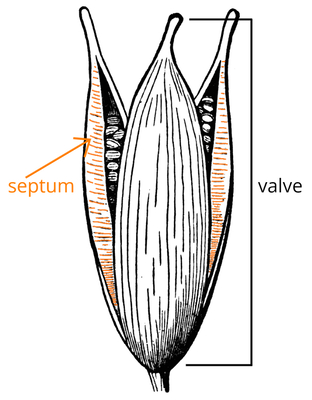 capsulecapsule:
capsulecapsule:
a dry, dehiscent fruit derived from a compound ovary or both, 3–60 mm long, globoseglobose:
or both, 3–60 mm long, globoseglobose:
3D shape—more or less spherical to trigonoustrigonous:
to trigonoustrigonous:
3D shape—having three faces that meet at distinct angles; triangular in outline
, tereteterete:
approximately circular in cross section; width and thickness approximately equal
 or angledangular:
or angledangular:
2D shape—having sides that meet at acute or obtuse angles
in transection, sometimes styles persistent, sometimes winged with an attenuate beakbeak:
a usually firm, terminal appendage, sometimes tapered , with many seeds. Fruits rarely indehiscentindehiscent:
, with many seeds. Fruits rarely indehiscentindehiscent:
not opening on its own, as in a fruit
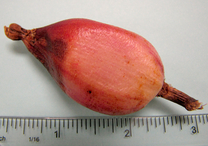 and one seeded (some species of Disporum). Pericarppericarp:
and one seeded (some species of Disporum). Pericarppericarp:
fruit wall or fruit coat
brown, green, blue, black, or blue (Disporum), shinyshiny:
uniformly reflecting a high proportion of incident light at all angles or dulldull:
or dulldull:
reflecting only a low proportion of incident light, with no apparent sheen , leatheryleathery:
, leatheryleathery:
texture—moderately thick, tough, and very pliable
, fleshy or membranousmembranous:
texture—extremely thin, pliable, and fairly tough
, smooth, wrinkled, ridgedridged:
surface relief—raised, thick ridges, sharp edged or rounded, usually in a series that may cover the entire surface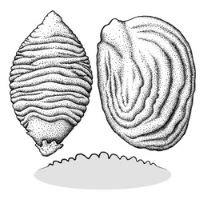 , or glandularglandular:
, or glandularglandular:
surface relief—covered with small, raised secretory glands, regular or irregularly shaped, translucent or opaque, and maybe distinctly colored .
.
Seeds globoseglobose:
3D shape—more or less spherical to angularangular:
to angularangular:
2D shape—having sides that meet at acute or obtuse angles
or discoiddiscoid:
3D shape—resembling a disc
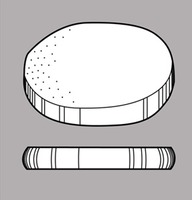 , 1–4 mm long, rapheraphe:
, 1–4 mm long, rapheraphe:
a ridge or seam on the seed coat, formed by the portion of the funiculus united to the ovule wall in longitudinally curved ovules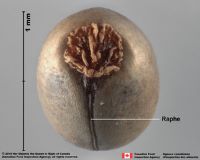 sometimes conspicuous (Iphigenia). StrophiolesStrophiole:
sometimes conspicuous (Iphigenia). StrophiolesStrophiole:
appendage or outgrowth of seed coat near the hilum and micropyle
present in Kuntheria, Schelhammera*, Tripladenia, and Uvularia. Fleshy arilsaril:
(broad sense) appendicular structure that wholly or partly envelops a seed and is produced from or a modification of the funicle, raphe, or outer integument; usually fleshy or pulpy, sometimes spongy or tufted-capillate, often brightly colored present in Gloriosa (red) and Uvularia. Sarcotestasarcotesta:
present in Gloriosa (red) and Uvularia. Sarcotestasarcotesta:
pulpy or fleshy outer layer of the seed coat, simulates aril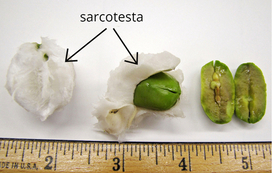 present in Littonia. In Ornithoglossum, carunclescaruncle:
present in Littonia. In Ornithoglossum, carunclescaruncle:
a localized outgrowth of the seed coat near the hilum of the seed; it functions as an elaiosome often present as an outgrowth of the rapheraphe:
often present as an outgrowth of the rapheraphe:
a ridge or seam on the seed coat, formed by the portion of the funiculus united to the ovule wall in longitudinally curved ovules . Colchicum seeds appendaged. Seed coat brown or red, firm, spongyspongy:
. Colchicum seeds appendaged. Seed coat brown or red, firm, spongyspongy:
soft, light, discontinuous but cohesive, and somewhat resilient
, or fleshy, smooth, wartywarty:
surface relief—distinct, rounded projections that are large relative to the fruit size; tuberculate, verrucose (Sandersonia, Androcymbium), or papillatepapillate:
(Sandersonia, Androcymbium), or papillatepapillate:
surface relief—bearing minute, distinct, broad-based projections, tapering to a rounded apex (Iphigenia).
(Iphigenia).
Embryo linearlinear:
(shape) long, narrow, and uniform in width; (of embryo) embryo is straight and much longer than wide , straight, may be very small and undifferentiated.
, straight, may be very small and undifferentiated.
Endosperm present.
*Strophiole absent in some species.
| Fruit | |
| Type | loculicidalloculicidal: type of capsular dehiscence, opening longitudinally through the locules (compare septicidal)  or septicidalsepticidal: or septicidalsepticidal:type of capsular dehiscence, opening longitudinally by separating between the septa of adjacent carpels  capsulecapsule: capsulecapsule:a dry, dehiscent fruit derived from a compound ovary  |
| Size range | 3–60 mm long |
| Shape(s) | globoseglobose: 3D shape—more or less spherical  , oblongoblong: , oblongoblong:2D shape—much longer than broad with nearly parallel sides, corners are rounded  , ellipsoidellipsoid: , ellipsoidellipsoid:3D shape—elliptic , cylindricalcylindrical: 3D shape—a cylinder, with parallel sides and a circular cross-section; tubular or rod-shaped , ovoidovoid: 3D shape—ovate  , trigonoustrigonous: , trigonoustrigonous:3D shape—having three faces that meet at distinct angles; triangular in outline |
| Texture | leatheryleathery: texture—moderately thick, tough, and very pliable , fleshy, membranousmembranous: texture—extremely thin, pliable, and fairly tough |
| Surface relief | smooth or wrinkledwrinkled: surface relief—shallow, irregular folds and furrows covering the surface; appearing overall though crumpled and then spread out  , ridgedridged: , ridgedridged:surface relief—raised, thick ridges, sharp edged or rounded, usually in a series that may cover the entire surface  , glandularglandular: , glandularglandular:surface relief—covered with small, raised secretory glands, regular or irregularly shaped, translucent or opaque, and maybe distinctly colored  |
| Color(s) | brown, green, blue, black |
| Seed | |
| Size range | 1–4 mm long |
| Shape(s) | globoseglobose: 3D shape—more or less spherical  , ovoidovoid: , ovoidovoid:3D shape—ovate  , polygonalpolygonal: , polygonalpolygonal:angular , discoiddiscoid: 3D shape—resembling a disc  |
| Surface relief | smooth, wartywarty: surface relief—distinct, rounded projections that are large relative to the fruit size; tuberculate, verrucose  , papillatepapillate: , papillatepapillate:surface relief—bearing minute, distinct, broad-based projections, tapering to a rounded apex  |
| Color(s) | brown, red |
| Unique features | Seeds brown or red, often with spongyspongy: soft, light, discontinuous but cohesive, and somewhat resilient or fleshy seed coats and usually with outgrowths. |
| Other | |
| Embryo | linearlinear: (shape) long, narrow, and uniform in width; (of embryo) embryo is straight and much longer than wide  , straight, may be very small and undifferentiated , straight, may be very small and undifferentiated |
| Nutritive tissue | endosperm present |
Temperate to tropical regions, Africa, Eurasia, Australia, Pacific Islands (New Zealand), and northern North America.
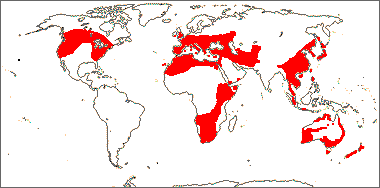
Distribution map courtesy of Angiosperm Phylogeny Website.
Baskin and Baskin 2021Baskin and Baskin 2021:
Baskin C and Baskin J. 2021. Relationship of the lateral embryo (in grasses) to other monocot embryos: A status up-grade. Seed Science Research 31 (3): 199-210. doi:10.1017/S0960258521000209; Dahlgren et al. 1985Dahlgren et al. 1985:
Dahlgren RMT, Clifford HT, and Yeo PF. 1985. The families of the monocotyledons: structure, evolution, and taxonomy. Springer-Verlag, Berlin. 520 pp.; Nooteboom et al. 2021+Nooteboom et al. 2021+:
Nooteboom HP, de Wilde WJJO, Stevens PF, Coode MJE, and Saw LG. 2021+ Flora Malesiana Online. Accessed January 2021–March 2024. URL: https://portal.cybertaxonomy.org/flora-malesiana/; Flora of Australia 2021+Flora of Australia 2021+:
Flora of Australia. Australian Biological Resources Study, Canberra. Accessed January 2021–March 2024. URL: http://www.ausflora.org.au; Flora of North America Editorial Committee 1993+Flora of North America Editorial Committee 1993+:
Flora of North America Editorial Committee, eds. 1993+. Flora of North America North of Mexico [Online]. 22+ vols. Flora of North America Association, New York and Oxford. Accessed January-March 2024. URL: http://beta.floranorthamerica.org.; Hoenselaar 2005Hoenselaar 2005:
Hoenselaar K. 2005. Colchicaceae. In: Beentje HJ and Ghazanfar SA, eds. Flora of Tropical East Africa Vol 43a. Royal Botanic Gardens, Kew, London UK. 19 pp.; Kirkbride et al. 2006Kirkbride et al. 2006:
Kirkbride JH, Jr, Gunn CR, and Dallwitz MJ. 2006. Family guide for fruits and seeds, vers. 1.0. Accessed September 2020-January 2022. URL: https://nt.ars-grin.gov/seedsfruits/keys/frsdfam/index.cfm .; Kubitzki et al. 1990+Kubitzki et al. 1990+:
Kubitzki K et al., eds. 1990+. The families and genera of vascular plants. 7+ vols. Berlin etc.; Stevenson and Loconte 1995Stevenson and Loconte 1995:
Stevenson DW and Loconte H. 1995. A cladistic analysis of monocot families. In: Rudall PJ, Cribb PJ, Cutler DF, and Humphries CJ, eds. Monocotyledons: Systematics and Evolution. Royal Botanic Gardens, Kew.; Tutin et al. 1964–1980Tutin et al. 1964–1980:
Tutin TG, Burges NA, Chater AO, Edmondson JR, Heywood VH, Moore DM, Valentine DH, Walters SM, and Webb DA (eds.) 1964–1980. Flora Europaea. 5 vols. Cambridge University Press, Cambridge UK. 2,524 pp.; Watson and Dallwitz 1992+Watson and Dallwitz 1992+:
Watson L and Dallwitz MJ. 1992+. The families of flowering plants: descriptions, illustrations, identification, and information retrieval. Version: 6th Accessed September 2020-September 2022. URL: delta-intkey.com; Zhengyi et al. 2004+Zhengyi et al. 2004+:
Zhengyi W, Raven PH, and Deyuan H. 2004+. Flora of China [online]. 25 vols. Science Press, Beijing China & Missouri Botanical Garden, St. Louis USA. Accessed January–March 2024. http://flora.huh.harvard.edu/china/
*The number of genera and species is based on Christenhusz and Byng 2016Christenhusz and Byng 2016:
Christenhusz MJM and Byng JW. 2016. The number of known plant species in the world and its annual increase. Phytotaxa 261 (3): 201-217. https://doi.org/10.11646/phytotaxa.261.3.1, which may differ from the number of genera in GRIN-Global.